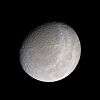Icy moon
Icy moons are a class of natural satellites with surfaces composed mostly of ice. An icy moon may harbor an ocean underneath the surface, and possibly include a rocky core of silicate or metallic rocks. It is thought that they may be composed of ice II or other polymorph of water ice.[1] The prime example of this class of object is Europa.
Icy moons warmed by tides may be the most common type of object to have liquid water, and thus the type of object most likely to have water-based life.
Some icy moons exhibit cryovolcanism, as well as geysers. The best studied example is Saturn's Enceladus.
Orbits
Most known large icy moons belong to giant planets, whose orbits lie beyond the Solar System's frost line; the remainder (such as Charon and Dysnomia) formed around dwarf planets such as Pluto, typically in large impacts not unlike the impact thought to have formed Earth's moon. In the case of icy gas giant satellites, an additional requirement is that a moon did not form in the inner region of a proto-satellite disk, which is too warm for ices to condense.
Europa is thought to contain 8% ice and water by mass with the remainder rock.[2] Jupiter's outer two Galilean moons Ganymede and Callisto contain more ice since they formed further from the hot proto-Jupiter.
Saturn's moon Titan looks and behaves more like Earth than any other body in the Solar System.[3] Titan is known to have stable pools of liquid on the surface.[3]
Images
-

Europa is believed to have a subsurface ocean
-

False-color image of Ganymede
-

Mimas has a density of 1.1 g/cm3
-

Active plumes on Enceladus
-

Titan showing surface and atmospheric details
-

Miranda has a scarred surface
-

A potential frost deposit on Umbriel's pole
-

A cloud over the limb of Triton
References
- ↑ Chaplin, Martin (2007-10-26). "Ice-two structure". Water Structure and Science. Retrieved 2008-01-02.
- ↑ Canup, Robin M.; Ward, William R. (2008). "Origin of Europa and the Galilean Satellites". arXiv:0812.4995
 .
. - 1 2 Rosaly Lopes; Robert M. Nelson (2009-08-06). "Surface features on Titan form like Earth's, but with a frigid twist". IAU. Retrieved 2009-12-21.

